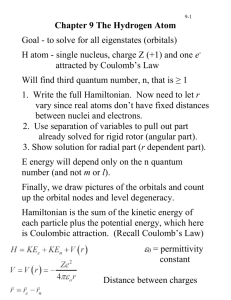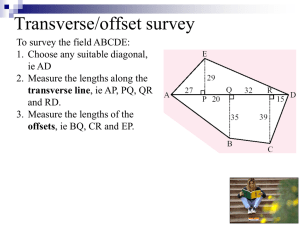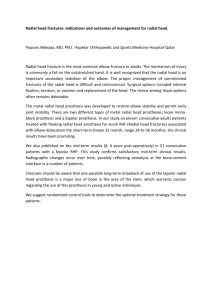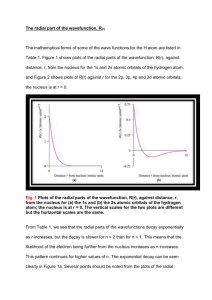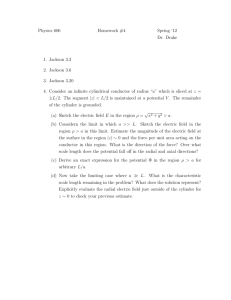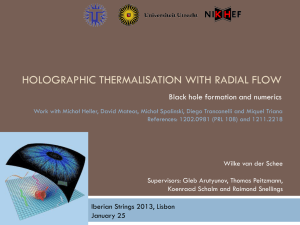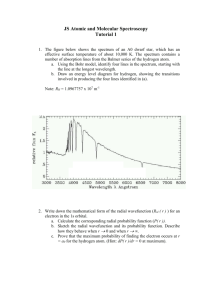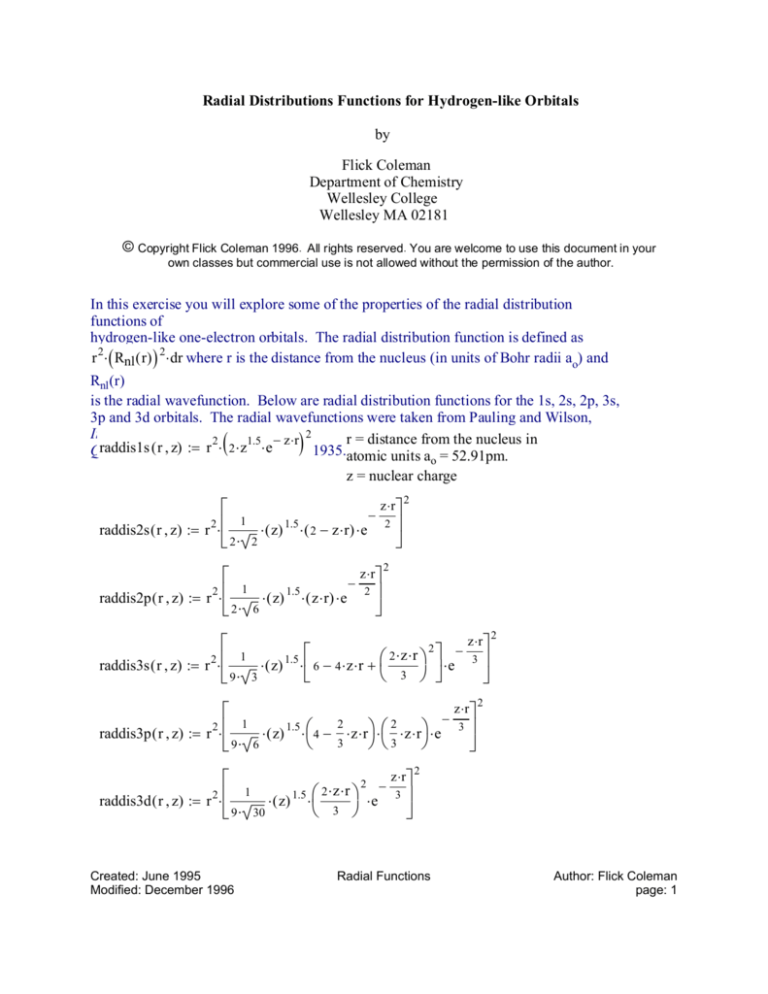
Radial Distributions Functions for Hydrogen-like Orbitals
by
Flick Coleman
Department of Chemistry
Wellesley College
Wellesley MA 02181
© Copyright Flick Coleman 1996.
All rights reserved. You are welcome to use this document in your
own classes but commercial use is not allowed without the permission of the author.
In this exercise you will explore some of the properties of the radial distribution
functions of
hydrogen-like one-electron orbitals. The radial distribution function is defined as
r 2⋅ ( Rnl ( r) ) 2⋅ dr where r is the distance from the nucleus (in units of Bohr radii ao) and
Rnl (r)
is the radial wavefunction. Below are radial distribution functions for the 1s, 2s, 2p, 3s,
3p and 3d orbitals. The radial wavefunctions were taken from Pauling and Wilson,
2
Introduction to
r = distance from the nucleus in
1.5 − z ⋅ r
raddis1sMechanics,
( r , z) := r 2⋅ McGraw-Hill,
2⋅z ⋅e
Quantum
1935.atomic units a = 52.91pm.
o
z = nuclear charge
(
)
z ⋅r
−
1
raddis2s ( r , z) := r 2⋅
⋅ ( z) 1.5 ⋅ ( 2 − z ⋅ r) ⋅ e 2
2
⋅
2
z ⋅r
−
2 1
1.5
raddis2p ( r , z) := r ⋅
⋅ ( z) ⋅ ( z ⋅ r ) ⋅ e 2
2⋅ 6
2
2
z ⋅r
2
−
2
⋅
z
⋅
r
1
⋅e 3
raddis3s ( r , z) := r 2⋅
⋅ ( z) 1.5 ⋅ 6 − 4 ⋅ z ⋅ r +
3
9
3
⋅
z ⋅r
−
2
2
2 1
1.5
raddis3p ( r , z) := r ⋅
⋅ ( z) ⋅ 4 − ⋅ z ⋅ r ⋅ ⋅ z ⋅ r ⋅ e 3
3 3
9⋅ 6
z ⋅ r
2 −
2
⋅
z
⋅
r
1
⋅e 3
raddis3d ( r , z) := r 2⋅
⋅ ( z) 1.5 ⋅
3
9
⋅
30
Created: June 1995
Modified: December 1996
2
2
2
Radial Functions
Author: Flick Coleman
page: 1
The interpretation that we commonly place on the radial distribution function is that it
represents the probability of finding the electron at a distance r from the nucleus,
independent
of angle (so it represents the probability of finding the electron on the surface of a sphere
of radius r). This interpretation can be restated in terms of electron density to say that the
radial
distribution function represents the electron density on the surface of a sphere of radius r.
Given this interpretation, how would you interpret the value of the integral of the radial
distribution function between r=0 and r=r? In the integrals below, you can change the
function being integrated and the nuclear charge, as well as the limits of integration. Play
around with the integrals varying these parameters and describe how the results either
support
or refute your understanding of the radial distribution function. How can you verify that
these
25
25
25
⌠are indeed probability functions?
⌠
⌠
raddis1s ( r , 1) dr = 1
raddis2p ( r , 1) dr = 1
raddis3d ( r , 1) dr = 0.997
⌡0
⌡0
⌡0
Now prepare some plots of radial distribution functions for various orbitals. Use these plots to
compare the relative sizes of orbitals and find internal radial nodes. Below is a sample plot for
the 1s, 2s and 3s orbitals.
r := 0 , .1 .. 25 choose a range of r values to plot the functions over
0.6
raddis1s ( r , 1)
0.4
raddis2s ( r , 1)
raddis3s ( r , 1)
0.2
0
0
5
10
15
20
25
r
Sample plot of radial distribution functions
Created: June 1995
Modified: December 1996
Radial Functions
Author: Flick Coleman
page: 2
to get at the concept of the "size" of an orbital find the distance you
need to go from the nucleus to include 90-90% of the electron density
⌠r
ed ( r , z) := raddis1s ( r , z) dr
⌡0
r := 0 .. 10
r =
0
1
2
3
4
5
6
7
8
9
10
ed ( r , 1) =
0
0.323
0.762
0.938
0.986
0.997
0.999
1
1
1
1
now differentiate the 1s function and solve for r at the minimum and maximum
(
) 2 by differentiation, yields
3.0
⋅ exp ( −z ⋅ r) 2 − 8 ⋅ r 2⋅ z 4.0 ⋅ exp ( −z ⋅ r) 2has solution(s)
r 2⋅ 2 ⋅ z 1.5 ⋅ e − z ⋅r
8⋅r ⋅z
0
1
z
r = 0 is the nucleus and r = 1/z (= 1 for z = 1)
is the maximum highest electron density or
most probable distance if you use a particle
model
Created: June 1995
Modified: December 1996
Radial Functions
Author: Flick Coleman
page: 3
r := 0 , .03 .. 10
look at the effect of nuclear charge on the
radial distribution function
effect of z on radial distribution
1.5
1
raddis1s ( r , 1)
raddis1s ( r , 2)
0.5
0
0
2
4
6
8
10
r
Do 2s and 2p have the same energy? It doesn't look like they are the same
"size".
The energy of an electron in an orbital is given by the expression
large_r
⌠
E = −.5 ⋅
⌡0
raddis
dr
r
For the case of 2s and 2p.
⌠
E2s := −.5 ⋅
⌡
25
raddis2s ( r , 1)
dr
r
0
E2s = −0.125
Created: June 1995
Modified: December 1996
⌠
E2p := −.5 ⋅
⌡
25
raddis2p ( r , 1)
dr
r
0
E2p = −0.125
Radial Functions
Author: Flick Coleman
page: 4
compare this to the energy of the 1s orbital
⌠
E1s := −.5 ⋅
⌡
25
raddis1s ( r , 1)
dr
r
0
E1s = −0.5
These energies are in atomic units. Note that the result is consistent with the model
that says that the energy of an orbital goes as 1/n2. It is also consistent with our
convention that more stable energies are more negative.
The plot below shows that although the 2s orbital appears to extend further into
space, the region closest to the nucleus is going to be most important in determining
the energy.
0.1
0.08
raddis2s ( r , 1)
0.06
r
raddis2p ( r , 1)
0.04
r
0.02
0
0
5
10
r
Created: June 1995
Modified: December 1996
Radial Functions
Author: Flick Coleman
page: 5
Created: June 1995
Modified: December 1996
Radial Functions
Author: Flick Coleman
page: 6



